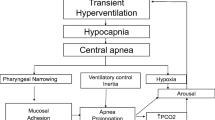Opinion statement
Patients with complex sleep apnea syndrome (CompSAS) present with features of obstructive sleep apnea syndrome but demonstrate not only instability of upper airway tone (leading to classic obstructive apneas and hypopneas) but also unstable, chemosensitive ventilatory control leading to repetitive central apneas or periodic breathing during sleep. The central apneas often become most apparent after application of continuous positive airway pressure (CPAP) to alleviate upper airway obstruction; patients continue to have fragmented sleep and repetitive desaturations as a result of central apneas and hypopneas. In some patients, central apneas appear to abate over time as a result of some form of adaptation to CPAP. How often this occurs is uncertain, however, and many patients with CompSAS require treatment that combines stabilization of the upper airway obstruction with treatment of respiratory center dysfunction. Adaptive servo-ventilation, which provides both a minimum pressure to hold the airway open and a precisely calculated ventilatory assist to minimize cyclic hypoventilation and hyperventilation, has emerged as a leading treatment. Noninvasive ventilation using bilevel positive airway pressure in the spontaneous-timed mode also may regulate ventilation in some patients with CompSAS. There is anecdotal evidence that CompSAS may be successfully treated using combined PAP therapy with oxygen, carbon dioxide, or the addition of dead space, but data are not sufficient to routinely recommend these methods.
Similar content being viewed by others
References and Recommended Reading
Gilmartin GS, Daly RW, Thomas RJ: Recognition and management of complex sleep-disordered breathing. Curr Opin Pulm Med 2005, 11: 485–493.
Thomas RJ, Terzano MG, Parrino L, Weiss JW: Obstructive sleep-disordered breathing with a dominant cyclic alternating pattern-a recognizable polysomnographic variant with practical clinical implications. Sleep 2004, 27: 229–234.
Morgenthaler TI, Kagramanov V, Hanak V, Decker PA: Complex sleep apnea syndrome: is it a unique clinical syndrome? Sleep 2006, 29: 1203–1209.
Morgenthaler TI, Gay PC, Gordon N, Brown LK: Adaptive servoventilation versus noninvasive positive pressure ventilation for central, mixed, and complex sleep apnea syndromes. Sleep 2007, 30: 468–475.
Kuzniar TJ, Pusalavidyasagar S, Gay PC, Morgenthaler TI: Natural course of complex sleep apnea—a retrospective study. Sleep Breath 2008, 12: 135–139.
Allam JS, Olson EJ, Gay PC, Morgenthaler TI: Efficacy of adaptive servoventilation in treatment of complex and central sleep apnea syndromes. Chest 2007, 132: 1839–1846.
Dernaika T, Tawk M, Nazir S, et al.: The significance and outcome of continuous positive airway pressure-related central sleep apnea during split-night sleep studies. Chest 2007, 132: 81–87.
Lehman S, Antic NA, Thompson C, et al.: Central sleep apnea on commencement of continuous positive airway pressure in patients with a primary diagnosis of obstructive sleep apnea-hypopnea. J Clin Sleep Med 2007, 3: 462–466.
Pusalavidyasagar SS, Olson EJ, Gay PC, Morgenthaler TI: Treatment of complex sleep apnea syndrome: a retrospective comparative review. Sleep Med 2006, 7: 474–479.
Randerath WJ, Galetke W, Stieglitz S, et al.: Adaptive servo-ventilation in patients with coexisting obstructive sleep apnoea/hypopnoea and Cheyne-Stokes respiration. Sleep Med 2008 (in press).
Thomas RJ, Daly RW, Weiss JW: Low-concentration carbon dioxide is an effective adjunct to positive airway pressure in the treatment of refractory mixed central and obstructive sleep-disordered breathing. Sleep 2005, 28: 69–77.
Author information
Authors and Affiliations
Corresponding author
Rights and permissions
About this article
Cite this article
Kuźniar, T.J., Morgenthaler, T.I. Treatment of complex sleep apnea syndrome. Curr Treat Options Neurol 10, 336–341 (2008). https://doi.org/10.1007/s11940-008-0036-7
Published:
Issue Date:
DOI: https://doi.org/10.1007/s11940-008-0036-7




